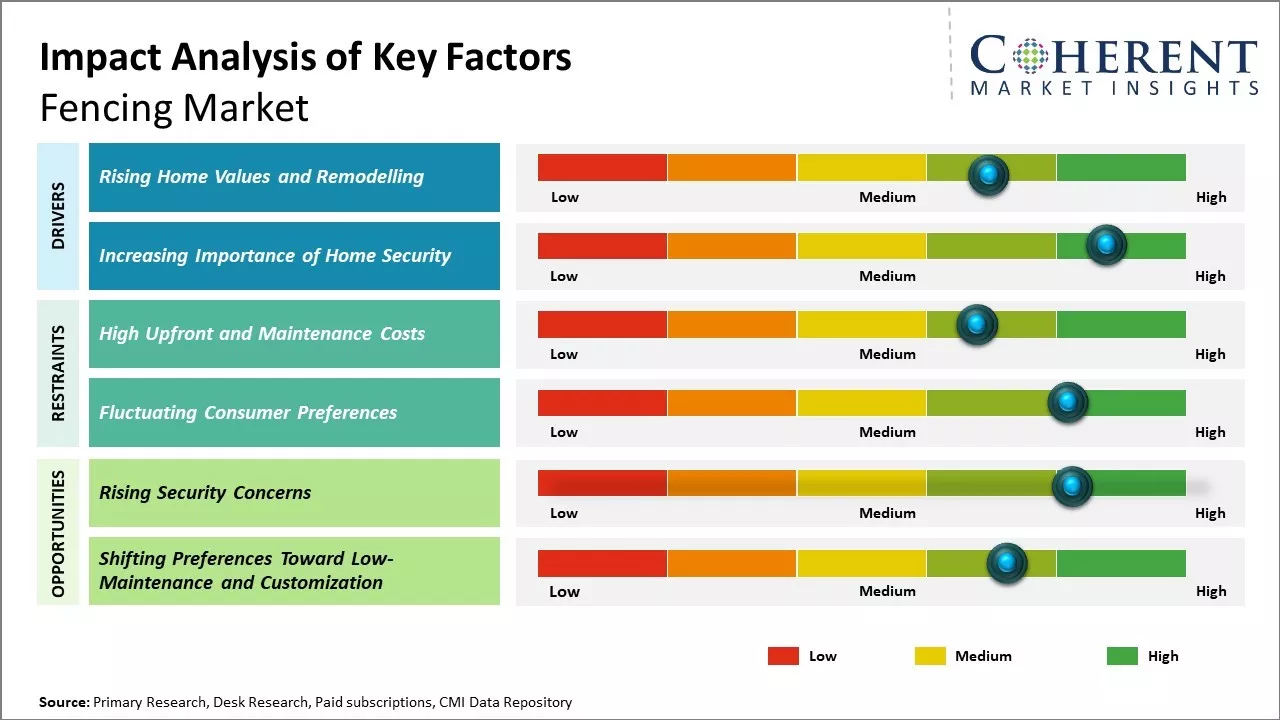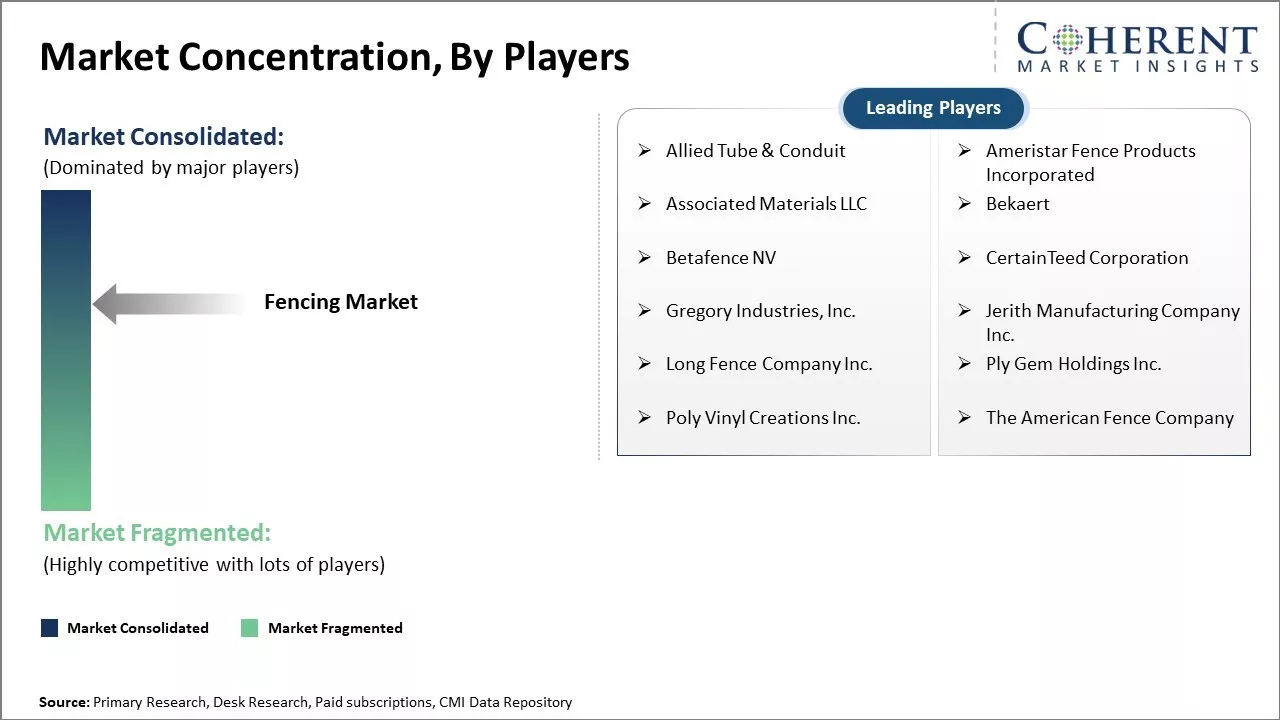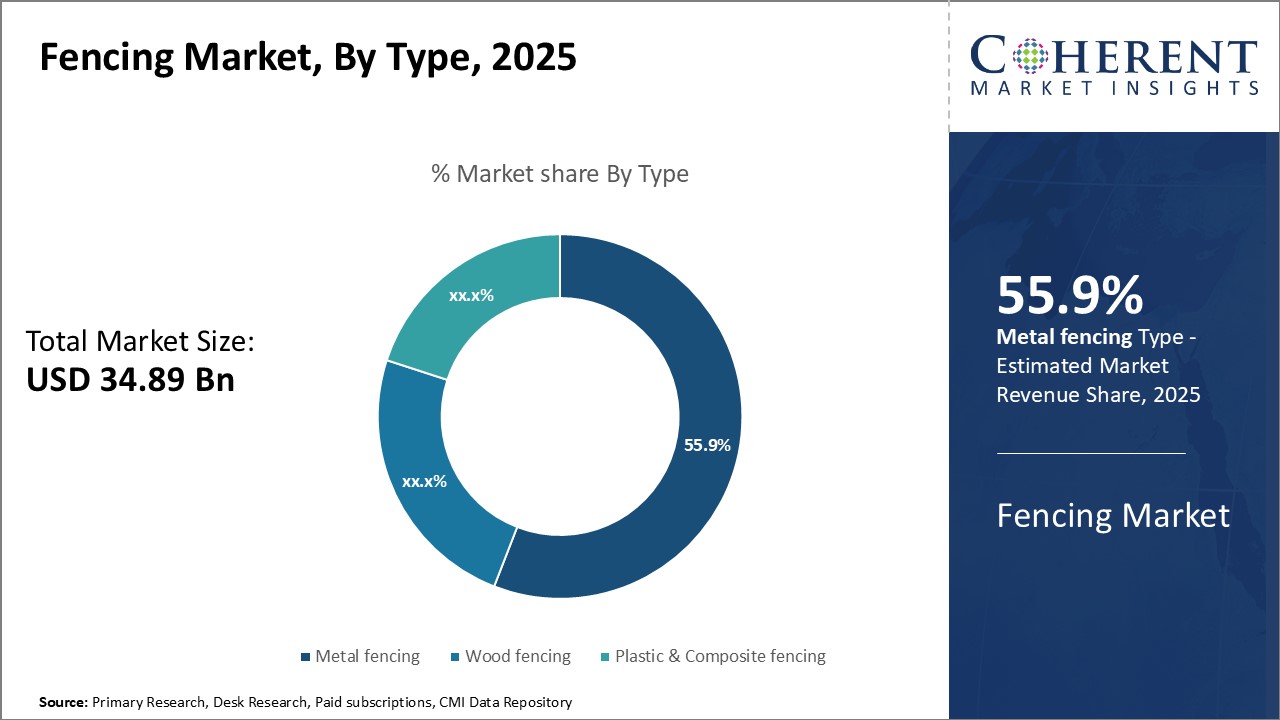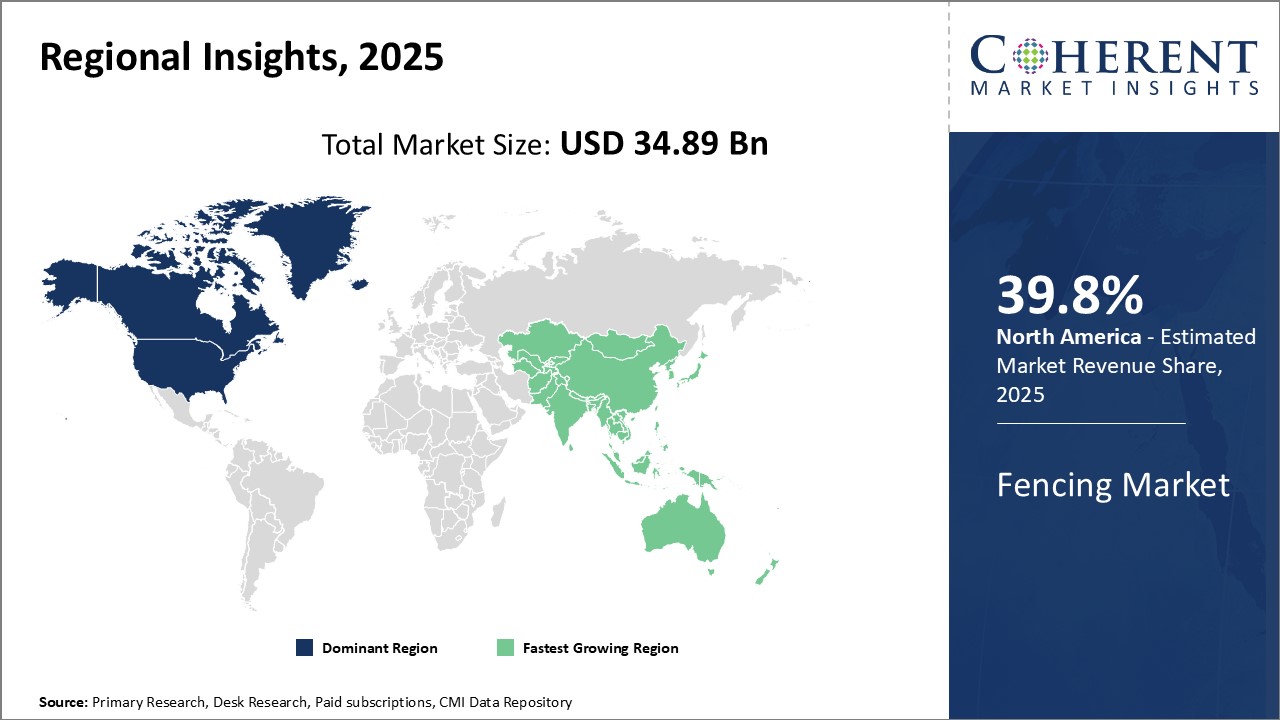The Fencing Market is estimated to be valued at USD 34.89 Billion in 2025 and is expected to reach USD 52.49 Billion by 2032, exhibiting a compound annual growth rate (CAGR) of 6.0% from 2025 to 2032.

Discover market dynamics shaping the industry: Request sample copy
Factors such as a rise in the adoption of smart fencing technologies integrated with IoT capabilities and surveillance cameras for enhanced security and growing need for perimeter security across residential and commercial complexes are expected to drive the demand for fencing. Additionally, rising spending on infrastructure development worldwide and increasing usage of fencing in agricultural sector for livestock management are further expected to support the market growth during the forecast period.
Rising Home Values and Remodelling
As home values continue to appreciate year after year in many markets across the country, homeowners feel more comfortable investing larger amounts of money into upgrades and renovations for their homes. Fencing is one of the most common outdoor projects that homeowners tackle when they want to increase their property's curb appeal and security. Replacing or installing new fencing has become a very popular remodeling and renovation project. Contractors report steady demand from homeowners’ association for community-wide fencing replacements. This driver bodes well for continued demand for fencing for both residential and light commercial applications.
For instance, in August 2021, the National Association of Home Owners' Maryland-based Home Renovation Research Lab, which conducts research on building trends, reported a significant increase in home fencing since the pandemic, with around 320 million linear feet of new fencing installed in the U.S.

Get actionable strategies to beat competition: Request sample copy
Increasing Importance of Home Security
With growing concerns over safety and security, having proper fencing has become a priority for many homeowners. News reports of break-ins, theft and property damage have contributed to rising fears. Homeowners seek reassurance that comes with fences that clearly mark the boundaries of their property and deter intruders. Fencing companies have responded with products customized for residential security needs including reinforced panels, anti-climbing electric fences, and smart locks for automated gates. This concern for safety enhances demand and drives homeowners to fortify and enclose their properties.
For instance, in August 2023, the U.S. Representative Pramila Jayapal, D-Seattle, spent over US$ 45,000 on home security in 2023, using campaign funds, as reported by Federal Election Commission records. As the leader of the Congressional Progressive Caucus, Jayapal is among many congressional leaders who have increased their spending on personal security. This trend has grown since the January 6, 2021, Capitol riot and the heightened polarization in the political climate.
Key Takeaways from Analyst:
The rising demand for suburban homes with spacious backyards and the increasing popularity of outdoor activities are some of the key drivers boosting the market growth. However, cyclical changes in the housing and construction industries may pose challenges to steady demand. The market also faces constraints due to rising raw material prices and trade issues that disrupt supply chains.
North America currently dominates the fencing market share due to the high rate of new housing starts and trends favoring larger residential properties with enclosing yards. However, Asia Pacific is projected to be the fastest growing regional market. This can be attributed to rising income levels, rapid urbanization, and increasing spending on lifestyle upgrades and leisure activities in densely populated cities.
Within fencing products, the wooden fencing segment continues to account for a major portion of spending. But, the demand for vinyl, PVC, and composite fencing materials is gaining momentum as they require less maintenance and can last longer than wood. The commercial sector presents promising opportunities, especially for projects involving perimeter security, airport runways, public parks, and sports facilities. Strategic partnerships with construction companies and tapping non-residential end-users can help players capitalize on these prospects.
Market Challenges: High Upfront and Maintenance Costs
Fencing installation can be expensive for both residential and commercial clients. Even though non-wood options are becoming popular, they can be pricier than traditional wood fences. Additionally, damage from weather or animals necessitates repairs and replacements over time, adding to the overall cost.
Market Opportunities: Rising Security Concerns
Crime rates, vandalism, and even worries about privacy are prompting many to secure their properties. A well-placed fence acts as a deterrent and creates a physical barrier, providing peace of mind. With a growing emphasis on " defensible space" concepts, property owners are creating clear boundaries to deter unwanted access.

Discover high revenue pocket segments and roadmap to it: Request sample copy
In terms of Type, Metal fencing holds the highest share of the market owing to its durability and versatility
The Metal Fencing segment is estimated to hold the highest share of 55.9% in 2025, due to its strength and longevity. Metal fences can withstand weathering from rain, wind, snow, and temperature extremes much better than other materials like wood or plastic. While other materials may crack, warp, or decay over time with exposure to the elements, metal fences retain their structural integrity for decades with little maintenance needed.
Metal fencing is also highly versatile, coming in a variety of styles to suit different architectural needs and aesthetics. Options include tubular steel, wrought iron, and chained link among others. This allows metal fencing to complement both traditional and modern design sensibilities. Customizable features like paint colors, top rail patterns, and post finials further expand the creative applications of metal fencing. Due to its strength and personalized design capabilities, contracting businesses increasingly specify metal fencing for larger industrial and commercial sites.
The combination of durability and versatility gives metal fencing prominent usage in a wide array of fencing applications. This broad functionality and appeal have allowed the metal fencing segment to achieve the largest market share compared to other materials. Demand is expected to remain strong as both residential and commercial property owners recognize the long-term value and diverse design possibilities that metal fencing provides.
Residential application holds the highest share of fencing demand due to growth in home construction and renovations
The residential sector makes up the greatest portion of fencing installations, which is estimated to hold a market share of 34.1% in 2025. This is driven in large part by continued expansion in single-family home construction and renovations across major global property markets. As more housing units are built and existing homes undergo improvements, demand is generated for surrounding each property with reliable perimeter fencing.
Privacy and security are two primary factors motivating residential fence installation. Homeowners desire well-defined boundaries enclosing their yards to prevent unwanted trespassing onto their property. Fences also provide visual and sound barriers secluding residences from neighboring lots. With modern lifestyles keeping more leisure and social activities occurring outdoors within private backyards, fencing allows residents to fully utilize these outdoor spaces without disturbance from adjacent areas.
Rather than just functional barriers, many residential fences now serve ornamental purposes as well. As yard design becomes increasingly integrated with overall architectural styles, matching or complementary fencing increases curb appeal and home value. Fences help define outdoor living areas like patios and gardens. Their visual impact is an important design consideration taken by homeowners renovating or those building new homes looking to optimize living experiences as well as real estate investment potential.
Strong underlying demand drivers from both security/privacy needs as well as aesthetic preferences have established the residential sector as the core consumer of fencing products and services. Ensuring high quality, customizable options remain available will be important for suppliers to maintain market share as home construction and makeovers continue worldwide.

Need a Different Region or Segment? Customize now
The North American region currently dominates the global fencing market and is estimated to hold a market share of 39.8% in 2025. With the U.S. being the largest economy in the region and one of the strongest construction industries globally, there is considerable demand for fencing products. The region is characterized by large residential and commercial infrastructure with many gated communities, housing complexes and industrial parks that rely on fencing for security and boundary demarcation.
Stringent government regulations regarding security also drive the need for sophisticated fencing solutions in North America. Many homeowners’ associations and local municipalities have bylaws that mandate certain standards for perimeter fencing, thereby creating a consistent market. Additionally, North American fencing manufacturers are global leaders in technological innovation. They continually release new automated gate systems, smart locks, and video surveillance-integrated products. This allows them to charge premium prices and maintain an edge over international competitors.
The Asia Pacific region has emerged as the fastest growing market and is expected to exhibit a CAGR of 6.89% for the forecast period of 2025-2031. Rapid urbanization and industrialization are taking place across developing countries like India and China. This has heightened the importance of partitioning lands, demarcating private and public boundaries as well as boosting security around new infrastructure projects. The exponential growth of special economic zones, manufacturing hubs, and gated communities has presented untapped opportunities for fencing vendors.
Further, several Asian governments are pouring millions into smart city initiatives that involve modern surveillance networks and digitally monitored perimeters. Thai and Singaporean cities especially have rolled out vast smart fencing projects encompassing perimeter detection sensors, centralized control systems, and advanced lock mechanics. Their success is dynamically shaping uptake in smaller Asian markets as well. Meanwhile, China's colossal manufacturing industry signifies extensive demand from industrial and logistic parks. Its position as the world's factory has made Asia Pacific impossible to overlook for global fencing corporations seeking new revenue pools.
Fencing Market Report Coverage
| Report Coverage | Details | ||
|---|---|---|---|
| Base Year: | 2024 | Market Size in 2025: | USD 34.89 Bn |
| Historical Data for: | 2020 To 2024 | Forecast Period: | 2025 To 2032 |
| Forecast Period 2025 to 2032 CAGR: | 6.0% | 2032 Value Projection: | USD 52.49 Bn |
| Geographies covered: |
|
||
| Segments covered: |
|
||
| Companies covered: |
Allied Tube & Conduit, Ameristar Fence Products Incorporated, Associated Materials LLC, Bekaert, Betafence NV, CertainTeed Corporation, Gregory Industries, Inc., Jerith Manufacturing Company Inc., Long Fence Company Inc., Ply Gem Holdings Inc., Poly Vinyl Creations Inc., and The American Fence Company |
||
| Growth Drivers: |
|
||
| Restraints & Challenges: |
|
||
Uncover macros and micros vetted on 75+ parameters: Get instant access to report
*Definition: The fencing market supplies a variety of fencing products and materials for residential and commercial use. This market provides things like wooden fences, vinyl fences, chain link fences, ornamental iron fences, and farm fencing to help define property boundaries and divide spaces. Products offered include fence panels, gates, posts, hardware such as hinges and latches, and fasteners like nails and screws. Customers can purchase different styles, heights, and designs of fencing suited to their property type and needs.
Share
Share
About Author
Ramprasad Bhute is a Senior Research Consultant with over 6 years of experience in market research and business consulting. He manages consulting and market research projects centered on go-to-market strategy, opportunity analysis, competitive landscape, and market size estimation and forecasting. He also advises clients on identifying and targeting absolute opportunities to penetrate untapped markets.
Missing comfort of reading report in your local language? Find your preferred language :
Transform your Strategy with Exclusive Trending Reports :
Frequently Asked Questions
Joining thousands of companies around the world committed to making the Excellent Business Solutions.
View All Our Clients
US Reciprocal Tax Impact Analysis On Fencing Market
Stay updated on tariff changes with expert insights and timely information